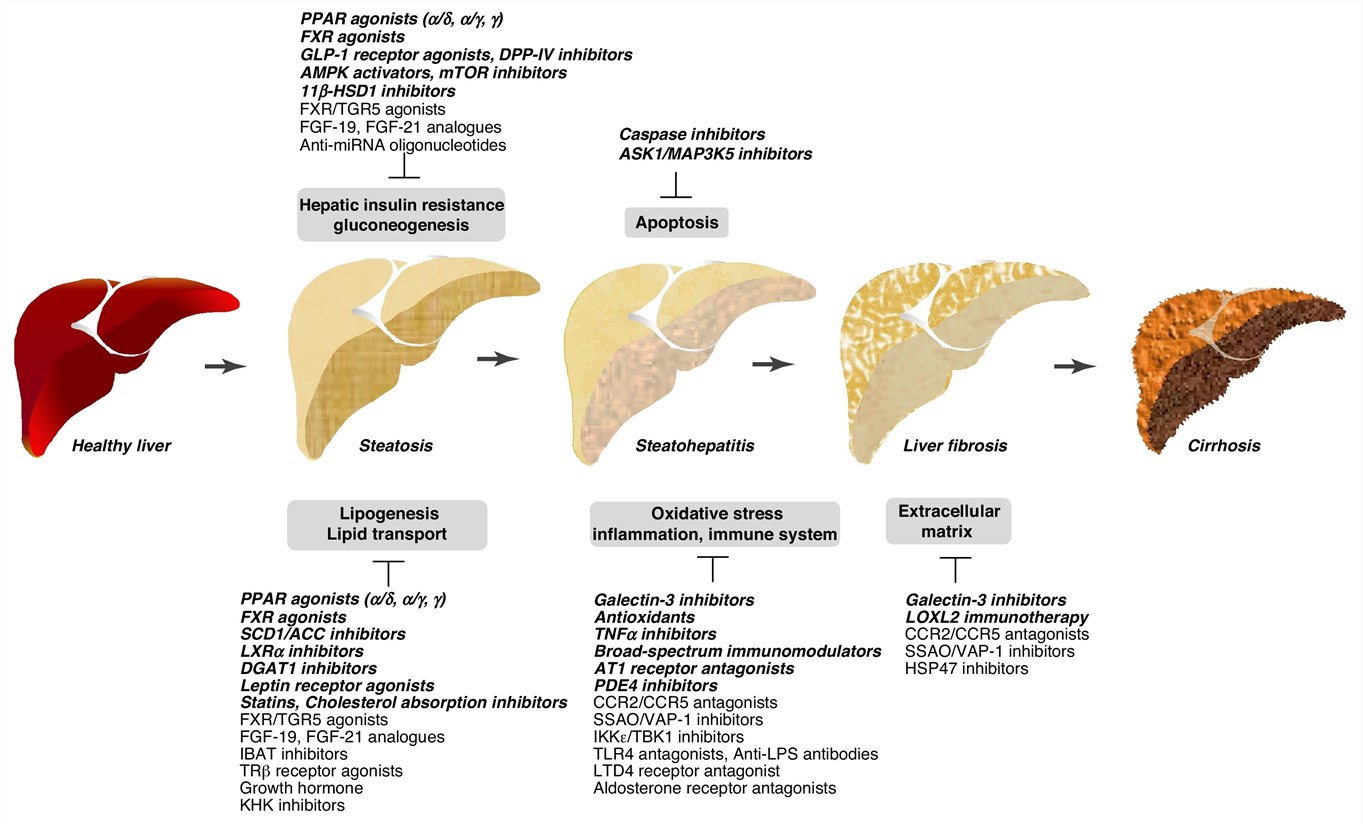NASH Target Development Services for Small Molecule Antagonist
Creative Biolabs has devoted to developing effective non-alcoholic steatohepatitis (NASH) therapeutic strategies and targets discovery for a long term. Based on our profound experience and advanced drug discovery platform, our scientists can provide tailored services for antagonists against various small molecules which are considered to be associated with hepatic fibrosis and NASH treatment.
Background
Deposition of excessive extracellular matrix proteins within the liver usually leads to hepatic fibrosis, which is also the natural result of chronic liver disease and liver inflammation. Generally, hepatic fibrosis is closely relevant to NASH, and they affect each other. There are many factors and related molecules/pathways causing hepatic fibrosis, most of which are also likely associated with the pathological mechanisms of NASH, such as hepatic galectin 3, lysyl oxidase-like protein 2, leukotriene receptor, caspase, hedgehog pathway, heat shock protein 47, CYR61 analogues and so forth. Therefore, therapeutic strategies targeting hepatic fibrosis pathologic molecules are potential pharmaceutical targets for NASH treatment.
 Fig.1 Hepatic drug classes in current (recruitment/active phase) or recently concluded clinical trials for NASH. (Hansen, 2017)
Fig.1 Hepatic drug classes in current (recruitment/active phase) or recently concluded clinical trials for NASH. (Hansen, 2017)
Small Molecule Targets in the NASH Treatment
As known to all, the pathogenesis of NASH is multifactorial such as lipotoxicity, oxidative stress, fibrosis, etc. Current NASH pharmacological therapies mainly aim at a target of a certain pathogenic factor to alleviate hepatic fat accumulation, insulin resistance or increase hepatic fat depletion, and the medical therapies directly targeting fibrosis molecules or pathways may be the most promising treatment. In addition to targets listed above, inhibitors or antagonists target on hepatic fibrosis small molecules may also be considered for the treatment of NASH. These potential small molecules include but not limited to:
-
Transforming Growth Factor-beta (TGF-β)
TGF-β is a critical cytokine with multiple regulatory functions and plays an important role in maintaining tissue homeostasis. TGF-β aberrant expression has a pro-fibrogenic effect which involves a number of hepatic disease processes. -
Integrin αᵥβ6
Hepatic integrin αᵥβ6 can be served as a biomarker for hepatic fibrosis since it is rarely expressed or deleted in healthy adult liver tissues, and is up-regulated when liver diseases occur. -
Endothelin-A Receptor
Endothelin 1 (ET-1) is a potent vasoconstrictor and mitogenic peptide in humans which can activate hepatic stellate cells (HSC) by binding to endothelin-A receptor, causing the progression of hepatic fibrosis. ET-1 or endothelin-A receptor antagonist is a novel treatment for hepatic fibrosis and NASH. -
Cannabinoid Receptors CB1, CB2
Cannabinoid receptors are of a kind of cell membrane receptors implicated in multiple physiological processes, including energy homeostasis, appetite, pain-sensation, etc. Cannabinoid CB1 receptor is mainly expressed in the brain while cannabinoid CB2 receptor mostly distributes in the immune system and in hematopoietic cells. Both CB1 and CB2 play different roles in cell apoptosis and fibrogenesis in the liver mediating different liver diseases. -
Connective Tissue Growth Factor (CTGF)
CTGF is a cysteine-rich extracellular matrix (ECM) associated heparin-binding protein that involves diverse biological processes and some pathologic pathways. In hepatocytes, CTGF is the downstream mediator of ECM synthesis induced by TGF-β1, which is strongly associated with liver fibrosis and NASH. -
Angiotensin-1 Receptor, Angiotensin Converting Enzyme (AT1/ACE)
Angiotensin II type 1 (AT1) is a G protein-coupled receptor that mediates numerous angiotensin II-induced biological functions, including cardiovascular effects, hormone secretion, renal function, ECM formation, etc. Angiotensin converting enzyme (ACE) is the key molecule in the renin-angiotensin system (RAS) that is responsible to convert angiotensin I to the active vasoconstrictor angiotensin II (Ang II). Researches revealed that the interaction between Ang II and AT1 can activate HSCs and increase TGF-β expression, which means AT1/ACE may play a non-negligible role in the hepatic fibrosis. -
Monocyte Chemoattractant Protein-1 (MCP-1)
MCP-1 is a small cytokine and an important chemokine with the ability of recruitment or regulation the migration and infiltration of monocytes/macrophages. MCP-1 is a potential biomarker of hepatic inflammation due to its inflammatory infiltration effect. By binding to C-C chemokine receptor (CCR) 2 in the liver, MCP-1 leads to infiltration of macrophages into obese adipose tissue and thereby induces NASH relevant insulin resistance and hepatic steatosis.
There are quantities of pharmaceutical targets displaying good therapeutic potential for NASH in addition to these hepatic fibrosis small molecules targets. As a pioneer and undisputed biological company, Creative Biolabs has devoted to NASH treatment research for over a decade, and now we are pleased to use our extensive experience and advanced platform (e.g. Hit to Lead, Lead Optimization, IND-Enabling, Target Identification, and Validation, Hit identification) to offer the best NASH services to boost our global customers’ research. Our scope of NASH services includes but not limited to:
- Biomarkers for NASH Diagnosis
- Target Discovery and Therapeutic Strategies
- Preclinical Models of NASH
You can directly contact us and communicate your specific demands with us for more information.
Reference
- Hansen, H.H.; et al. Mouse models of nonalcoholic steatohepatitis in preclinical drug development. Drug Discovery Today. 2017, 11(22): 1707-1718.
 For Research Use Only.
For Research Use Only.